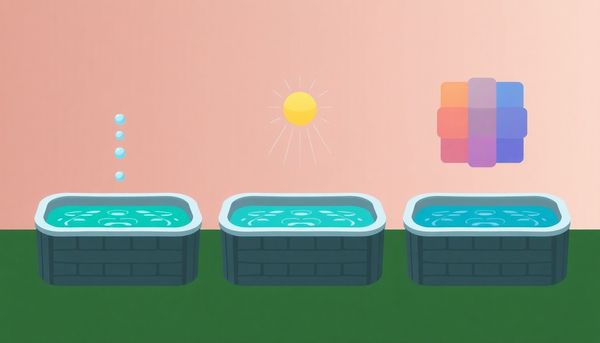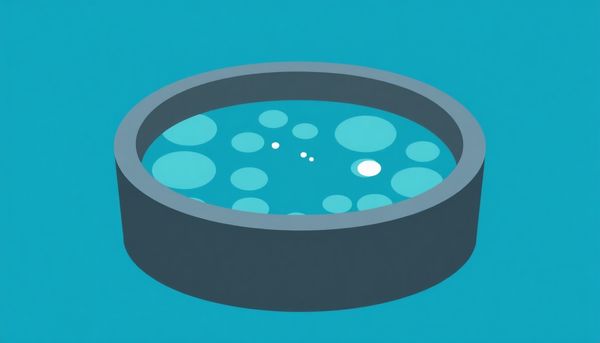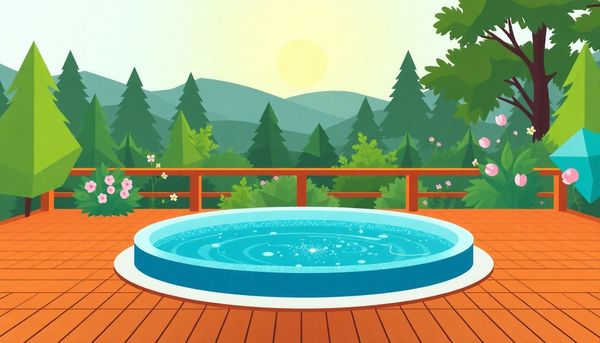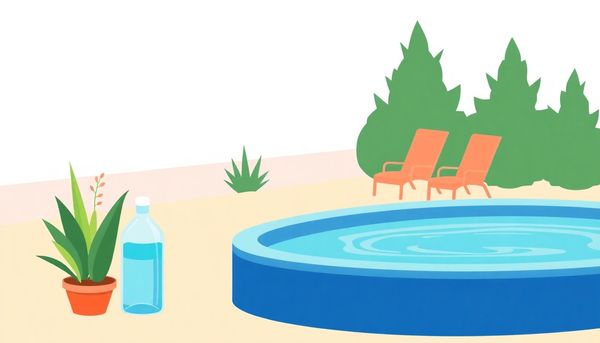Explore Gentle Hot Tub Sanitizers: Ozone, UV, and More
December 03th, 2024
December 03th, 2024
Soaking in a hot tub is often the ultimate way to unwind, yet maintaining its cleanliness can become a chore. Traditional chlorine and bromine sanitizers, while effective, sometimes bring with them an overpowering chemical smell or irritate sensitive skin. I remember a time when a friend, after a lovely evening in the hot tub, found her skin red and itchy. That experience sent us both on a quest to find alternatives that could offer a gentler, yet still effective, solution.
Seeking out different options can lead to surprising discoveries. For those looking to steer clear of harsh chemicals, alternative sanitizers present a refreshing change. Each option brings its unique set of benefits and considerations, catering to different needs and preferences. Whether it's the allure of an eco-friendly approach or the appeal of a less irritating solution, these alternatives promise a cleaner soak without the common drawbacks.
Friends rave about the possibilities—some swear by mineral-based systems, which harness natural elements to maintain clarity and safety. Others prefer the advanced technology of saltwater chlorinators that transform salt into a sanitizer seamlessly. UV systems and ozone generators also stand out as innovative methods, harnessing science to tackle bacteria and algae. Exploring these options not only enhances the hot tub experience but also empowers you to personalize your relaxation ritual.

Lying back in a hot tub, unwinding after a long day, should be a simple pleasure. Yet, for many, the overpowering scent of chlorine or the risk of skin irritation turns this leisure into a less enjoyable experience. Fortunately, the world of hot tub sanitization offers intriguing alternatives that steer clear of harsh chemicals.
Enter the realm of non-chemical sanitizers. These innovative solutions promise a cleaner experience without the downsides of traditional methods. Consider the ozonator, for instance. This gadget injects ozone into your hot tub, effectively zapping bacteria and contaminants. Though it might require an initial investment and potentially a spa modification, the reward is a soak free from chemical odors and irritations.
Another fascinating option lies in mineral purifiers. By releasing silver and copper ions, these purifiers naturally combat bacteria. Though they won't handle cloudiness or replace a good shock treatment, they significantly reduce the need for chlorine or bromine, making them an excellent supplementary system.
Then there's the biguanide approach, known for its gentle touch. Sold under brands like BaquaSpa, it ensures a sanitized soak without the dry skin aftermath, although it does require a specific shock treatment to maintain clarity.
Exploring these non-chemical alternatives might just transform your hot tub into a haven of relaxation, minus the chemical concerns. Dive into cleaner, gentler waters, and let your spa time be all about tranquility, not trouble.
Ozone-based solutions offer a compelling alternative for hot tub sanitation, channeling the power of ozone gas to purify water with remarkable efficiency. Unlike traditional sanitizers, which can leave skin dry and swimsuits faded, ozone provides a more natural approach by harnessing oxygen molecules to eliminate bacteria and viruses. One weekend, a friend of mine decided to switch to an ozone system after noticing the harsh effects of chlorine on her family’s skin. She described the change as transformative, with the water feeling softer and more inviting.
This method involves installing an ozonator in your hot tub, which injects ozone into the water. This process not only reduces the need for chemical sanitizers by up to 90% but also works tirelessly in the background, continually refreshing your spa. The initial investment might seem steep, but the long-term benefits—both financial and environmental—are substantial. Plus, there's no need to worry about that familiar, overpowering sanitizer smell; the ozone system keeps your hot tub odor-free.
Admittedly, setting up an ozonator can require some adjustments to your existing setup, but the trade-off is crystal-clear water minus the chemical cocktail. It’s like inviting a diligent, invisible housekeeper into your spa, always working to ensure a clean, safe environment. If you're aiming for a serene soak without the side effects of traditional chemicals, considering an ozone-based solution could be your ticket to a healthier hot tub experience.
Ultraviolet technology in hot tubs might sound like something out of a sci-fi flick, but it’s a practical and innovative solution for those hesitant about traditional sanitizers. Pulling inspiration from the sun itself, UV systems harness the power of ultraviolet light to neutralize bacteria and pesky contaminants in the blink of an eye. It’s like having a microscopic laser show that works tirelessly to keep your water clean.
Remember the first time you got your hot tub? You probably imagined endless relaxation, not a cloud of chemicals. UV technology offers a way to enjoy the therapeutic benefits of your spa without the chemical cocktail. It works by circulating water through a specialized UV chamber, where harmful microorganisms are zapped away before they get a chance to multiply. It’s effective and significantly reduces the need for chlorine or bromine, making it a sweet relief for sensitive skin.
However, there’s a small catch. UV systems excel at killing bacteria, but they don’t prevent cloudiness. You’ll still need to occasionally shock the water or use a touch of chlorine or bromine for optimal clarity. Despite this, the reduction in chemical use is substantial, and the benefits for your skin and swimsuit longevity are well worth the effort. As a friend would advise, if you’re looking to minimize chemical exposure while keeping your spa experience pristine, embracing UV technology might just be your next favorite upgrade.
Exploring the benefits of ionizers in your hot tub routine can be a game-changer, especially for those seeking a gentler and more natural method of sanitation. Ionizers deploy the power of silver and copper ions to combat bacteria and algae, offering a less abrasive alternative to traditional chemical sanitizers. Imagine this: slipping into your hot tub without the harsh, eye-watering scent of chlorine hanging in the air. Instead, the water feels softer, and you can soak without worrying about emerging with dry skin or faded swimwear.
The practicality of ionizers extends beyond just their sanitizing prowess. With them, you’re reducing your chemical footprint, which is not only kinder to your skin but also to your hot tub’s components. Metal ions effectively inhibit microbial growth, yet they work in tandem with minimal levels of chlorine or bromine, meaning you can still maintain crystal-clear water while using far less of these harsh chemicals.
It’s worth mentioning that the setup of an ionizer is straightforward, often involving nothing more than installing a mineral cartridge. This simplicity makes it a favorite for hot tub owners who prioritize easy maintenance. Having used one myself, the difference in water quality and the overall spa experience is undeniably positive. So, if you're on the lookout for an alternative that champions both comfort and cleanliness, an ionizer might just be your new best friend in hot tub care.

Gliding into the realm of salt water for your hot tub is akin to treating yourself to a gentle spa experience rather than a chemical wash. Salt water systems transform dissolved salt into chlorine through a process called electrolysis, but without the harsh side effects of traditional chlorine treatments. This transformation leads to a softer, more natural feel for your skin, leaving it nourished rather than parched like the desert sands.
My friend Sarah once shared her tale of woe, where each hot tub session left her scratching her arms and adjusting her swimsuit like she was wearing burlap. She switched to a salt water system, and the difference was as clear as day: no more itchy skin or mysteriously shrinking swimwear.
Moreover, salt water comes with an added bonus for the eco-conscious—it's a much gentler option for the environment. By reducing chemical buildup, not only do you pamper your skin, but you also lend a hand to Mother Nature. The system's ease of maintenance is another feather in its cap; fewer chemicals mean fewer adjustments needed, leaving you more time to bask in the bliss of your perfectly balanced tub.
In essence, a salt water hot tub isn't just an alternative; it's an invitation to a better bathing experience—one where comfort meets sustainability without compromising on cleanliness.
Venturing beyond the traditional realm of chlorine and bromine opens up a world of alternative hot tub sanitizers, each with its own unique benefits. Ozone systems, for instance, are gaining traction for their strong disinfection capabilities without the need for additional chemicals. Although they require an upfront investment and potential modifications to your hot tub, the payoff is water that is both clear and free from harsh chemical odors.
Silver and copper ionizers draw inspiration from ancient practices, capitalizing on their natural antibacterial properties. By releasing ions into the water, they help control bacteria growth while reducing dependency on more aggressive sanitizers. However, to maintain crystal clear water, occasional supplemental use of chlorine or bromine might still be necessary.
Ultraviolet (UV) sanitizers are another futuristic choice, employing UV light to neutralize microorganisms. While they excel at purifying, they don't address water clarity issues. Combining UV systems with periodic shocks tends to strike a balance, allowing you to minimize chemical exposure while ensuring safety.
For those with sensitivities, biguanide offers a kinder alternative, widely praised for its gentle nature on skin and eyes. Its popularity is bolstered by its inclusion in contact lens solutions. However, it demands the use of compatible shocks to maintain efficacy.
Ultimately, embracing any of these options can transform your hot tub experience, tailoring it to meet both personal comfort and health needs.
When sinking into a hot tub at the end of a long day, the last thing anyone wants is to emerge looking and feeling like they've been pickled in bleach. For those sensitive souls who find chlorine and bromine less than friendly to their skin, there's promising news. Chlorine-free options offer a gentler approach to keeping your hot tub clean, ensuring you enjoy every soothing soak without skin irritation or that unmistakable chemical tang.
One alternative worth considering is the saltwater sanitization system. This method uses a special generator to convert salt into chlorine, but at much lower levels than traditional methods. It's a softer solution that many users find more pleasant, not only for the skin but also for the hair, reducing the risk of those unsightly greenish hues in blonde locks. My friend Sarah swears by her saltwater hot tub, mentioning how her kids no longer complain of itchy skin after a soak.
Another option stepping into the spotlight is the mineral sanitizer. These systems release silver and copper ions into the water, effectively combating bacteria without the harshness of traditional chemicals. While not entirely replacement-free, they drastically reduce the need for chlorine or bromine. Mineral sanitizers are a hidden gem for those who cherish a more natural approach, offering a spa experience that feels as good as it looks. With these alternatives, the quest for a blissful, irritation-free soak is well within reach.
Stepping into a hot tub can be a luxurious escape, but for those with sensitive skin or eyes, chlorine and bromine can turn that dream into a stinging nightmare. So why not explore alternatives that provide comfort without compromising cleanliness? Biguanide, for instance, is a standout option. Not only does it sanitize effectively, but it also feels gentler on your skin and eyes. This is the same compound found in some contact lens solutions, underscoring its gentle touch.
Opting for a mineral-based system, like silver and copper ionizers, is another great choice. They naturally combat bacteria, giving you peace of mind without the harsh effects. Sure, they might need a little help from a small dose of chlorine or bromine, but your skin will thank you with fewer irritations.
Saltwater systems deserve a mention, too. They transform salt into a natural sanitizer through electrolysis, resulting in softer water that's less likely to cause dryness or eye irritation. My friend switched to saltwater, and she raves about how her skin feels smooth, even after long soaks.
Choosing alternatives like these doesn't just mean better skin and eye comfort—it also means a more enjoyable hot tub experience overall. So, why settle for less when you can bask in the luxury of a soothing soak without the sting?

For those who find the scent of chlorine less than appealing or suffer from its drying effects, ozone might just offer a refreshing escape. This invisible champion, often underappreciated, holds the power to sanitize your hot tub without leaving you feeling parched or bleached. Drawing from nature’s playbook, ozone is a naturally occurring molecule that effectively neutralizes bacteria, viruses, and other pathogens, all without the harsh side effects that come with traditional sanitizers.
Think back to those crisp, clean scents after a thunderstorm—that's ozone at work. By installing an ozonator, you harness this same natural purity for your spa. Unlike other systems that require frequent chemical refills, ozonators work tirelessly with minimal intervention. They inject ozone directly into the water, reducing your reliance on chemicals by up to 90%. This means less hassle for you and a gentler soak for your skin and swimwear.
While the initial setup of an ozonator may require a financial commitment and some technical adjustments to your hot tub, many find the investment worthwhile. My friend Sarah, who battled persistent skin irritation from chlorine, swears by her ozonator. The change was as clear as her now-sparkling spa water. With ozone, not only do you make a choice that respects your skin, but you also embrace an eco-friendlier way to enjoy your hot tub, aligning with a more sustainable lifestyle.
Ever found yourself cringing at the sharp scent of chlorine as you approach your hot tub? Or perhaps you've noticed your skin feels a bit too tight and dry after a relaxing soak? You're not alone. Many hot tub enthusiasts are seeking out alternatives that offer a gentler touch without compromising cleanliness. Enter the realm of alternative sanitizers, where innovation meets relaxation.
Ozone systems, for instance, might sound like something out of a sci-fi movie, but they’re grounded firmly in reality. These devices inject ozone gas into your spa, which acts as a powerful oxidizer, annihilating bacteria and viruses without the need for harsh chemicals. While initial setup might require a bit of an investment, the long-term benefits, both for your skin and your spa, make it an attractive option.
Then there's silver and copper ionizers. They've been trusted since ancient times for their antimicrobial properties. By releasing ions into the water, they combat bacteria effectively. Although you may still need a smidgen of chlorine or bromine to ensure your water stays crystal clear, the reduction in chemical use is noticeable.
And for those with particularly sensitive skin, biguanide might just be your spa's best friend. Known for its gentle nature, this sanitizer skips the harshness while maintaining its efficacy. It’s like slipping into a cashmere sweater instead of an itchy wool one.
Exploring these alternatives not only caters to sensitive skin but also enhances the overall hot tub experience. Sometimes, the path less chemically-fumed makes all the difference.
Turning your hot tub into a sanctuary free from harsh chemicals is not just a possibility; it's a pathway to a more enjoyable and healthier experience. Traditional sanitizers like chlorine and bromine do their job effectively, but they can leave your skin feeling dry, your swimsuit faded, and the air around your hot tub heavy with a distinctive, lingering scent. For those sensitive to these chemicals or simply seeking a more natural approach, alternative sanitizers offer a refreshing solution.
Consider the benefits of a saltwater hot tub. The softer, gentler water is a relief for both skin and eyes, providing a soothing soak without the aggressive effects associated with traditional chemicals. You can embrace the natural clean of salt, reducing the chemical load while still maintaining a safe environment.
Then there’s the power of ozone. Ozonators work by injecting ozone gas into the water, effectively sanitizing it without the need for additional chemicals. While this requires an initial investment and potentially some modifications to your hot tub, the payoff is cleaner water with minimal chemical interference.
Another contender in the battle against harsh chemicals is biguanide, a non-chlorine sanitizer that’s often found in contact lens solutions. It’s known for its gentle touch on skin and eyes, making it a popular choice for those who wish to avoid the adverse effects of traditional sanitizers.
Incorporating these alternatives can transform your hot tub into a more health-conscious oasis, allowing you to unwind without the worry of chemical exposure.
Long gone are the days when chlorine and bromine dominated the hot tub sanitation scene. Enter ozone technology, a modern marvel that transforms how we keep our spas pristine. Ozone, a naturally occurring molecule with potent disinfecting properties, offers a refreshing alternative to chemical-heavy solutions. Harnessing this technology means more than just clear water; it provides a cleaner, safer soak with reduced reliance on traditional sanitizers.
Ever notice how the air feels fresh after a thunderstorm? That's ozone at work, naturally purifying the atmosphere. Ozone generators, or ozonators, replicate this process in your hot tub. They inject ozone into the water, which then breaks down contaminants, including bacteria and viruses, in a seemingly magical yet scientific dance. This not only enhances the water quality but also minimizes that all-too-familiar chemical smell, creating a more pleasant spa experience.
Though installing an ozonator requires an upfront investment and possibly a few modifications to your hot tub setup, many spa enthusiasts find the benefits outweigh the costs. Less wear and tear on swimsuits, fewer skin irritations, and a dramatic reduction in chemical usage make ozone a worthy contender. Plus, the environmental bonus of using fewer chemicals aligns perfectly with eco-conscious lifestyles. By choosing ozone technology, you’re not just investing in your hot tub’s health but also in your personal well-being. Welcome to a cleaner, greener soak.

What if your next hot tub session could be both relaxing and gentle on your skin? Enter biguanide, a lesser-known but highly effective alternative to the traditional chlorine and bromine sanitizers. This chemical, often marketed under the name BaquaSpa or Baquacil, is renowned for its mild touch, making it a savior for those with sensitive skin or eyes. The same substance found in some contact lens solutions—listed as PHMB—biguanide is a testament to its safety for close contact with our most delicate tissues.
Think back to the last time you enjoyed your spa and emerged unscathed by dryness or itchiness. Biguanide brings that vision to life by maintaining the water's cleanliness without the harsh side-effects. It’s a game-changer, especially for those who've noticed their hair turning greenish or swimsuits fading after repeated dips in chlorinated water.
Now, you might wonder about the upkeep. While biguanide is an effective sanitizer, it does necessitate periodic shocking of the water, but steer clear of chlorine-based shocks. Instead, opt for a non-chlorine or non-bromine alternative to keep everything in balance.
Choosing biguanide can transform your hot tub experience, offering both serenity and skin-friendliness, proving that you don't have to compromise comfort for clean water. Embrace this gentle giant and let your spa sessions be as soothing as they should be.
While indulging in a hot tub session should be the epitome of relaxation, the lingering chemical scent of chlorine or bromine can be a deterrent for many. The good news is that the world of alternative sanitizers offers options that are both effective and less abrasive on the senses. For instance, if you've ever marveled at nature's ability to purify, you might appreciate the concept behind ozone sanitizers. They harness the power of ozone gas, injecting it into the water to neutralize bacteria and contaminants without leaving a chemical residue behind. This option might involve an initial investment for installation, but the payoff is a cleaner soak without the chemical cloud.
On the other hand, if you're drawn to ancient remedies, ionizers might pique your interest. These devices release silver and copper ions into the water, leveraging their natural antibacterial properties. Although ionizers alone can't prevent water cloudiness, they significantly reduce the need for traditional chemicals when used in combination with periodic shocks.
For those searching for a modern, minimalist approach, biguanide offers a compelling alternative. Known for its gentleness on skin and eyes, biguanide is a favorite among those with sensitivities. While it requires specific non-chlorine shocks to maintain clarity, its efficacy makes it a worthwhile contender.
Exploring these alternatives could transform your hot tub experience into a true oasis, free from the drawbacks of traditional sanitizers.
Soaking in a hot tub should feel like a blissful escape, not an irritation factory. Yet, for those with chemical sensitivities, the experience can be anything but relaxing. A close friend once described how she would emerge from her hot tub sessions with itchy, dry skin and hair that looked like it had been through a desert storm. It's a familiar story for many who have wrestled with the chemical giants, chlorine and bromine.
Fortunately, alternatives exist that can transform your hot tub into a sanctuary rather than a battleground. For starters, consider switching to a saltwater system. It feels like dipping into a gentle saline sea, leaving your skin softer and less prone to irritation. If you're concerned about your swimsuit fading faster than your summer tan, an ozonator might be your hero. It reduces the dependency on harsh chemicals, keeping those vibrant colors intact.
Moreover, for those who seek an entirely different approach, mineral-based sanitizers like silver and copper ionizers offer a gentler experience. They may not handle all the heavy lifting alone, but they drastically cut down on chemical exposure. It's akin to having a natural spa retreat right in your backyard.
Exploring these alternatives can help you enjoy your hot tub without the worry of turning crispy and uncomfortable. Dive into a world where relaxation doesn't come at the cost of your skin's comfort.
In the realm of hot tub sanitization, ozone sanitation stands out as a remarkable, chemical-free alternative. Imagine lounging in your hot tub, enveloped not by the harsh scent of chemicals but by the gentle embrace of freshly purified water. This is the promise of ozone sanitation. Unlike traditional methods that often leave your skin feeling dry or irritated, ozone sanitizers work quietly and effectively by injecting ozone gas into the water. This gas acts as a powerful oxidizing agent, eliminating bacteria, viruses, and other contaminants without leaving any residue.
Consider the ease of maintenance this brings. Ozone systems reduce the need for additional sanitizing chemicals by up to 90%, meaning fewer trips to the store and less time spent adjusting chemical levels. For those wary of potential chemical reactions or who have sensitive skin, this is a game changer. Friends who have switched often rave about how their swimsuits stay vibrant and their skin remains smooth, even with frequent use.
Moreover, while the initial investment might be higher compared to other options, the long-term benefits are substantial. Ozonators typically require less frequent replacement than chemical supplies, making them a cost-effective solution over time. For anyone seeking cleaner water with minimal effort and maximum comfort, embracing ozone sanitation is a decision that refreshes both body and mind.

In the quest for pristine hot tub water, ultraviolet (UV) technology offers a fascinating alternative. While lounging in my friend's garden, I once noticed her hot tub glistening under the afternoon sun. Instead of the sharp scent of chlorine, there was a freshness in the air. She introduced me to her secret: a UV sanitizer. This method uses the invisible power of UV light to eliminate bacteria and other unwanted guests lurking in the water, much like how sunlight purifies naturally.
The magic lies in the UV bulb encased within the sanitizer unit, which bathes the water in germicidal light as it circulates through the system. Unlike traditional chemicals, UV sanitation leaves no residue and adds no odor, allowing you to soak without the telltale chlorine smell. The real beauty is that it helps reduce dependency on chlorine and bromine, which can irritate sensitive skin and eyes.
However, it's important to remember that while UV sanitizers are highly effective at killing microorganisms, they don’t clarify the water. Therefore, regular maintenance like shocking remains necessary to keep your spa sparkling. My friend's trick was to combine her UV system with occasional use of mineral sanitizers, creating a balanced, less chemically intrusive hot tub experience. For those seeking a blend of science and serenity, UV power might just hold the key to cleaner, calmer waters.
In the quest for a refreshing and comfortable hot tub experience, the significance of choosing the right sanitizer cannot be overstated. While chlorine and bromine have long been the go-to options, they aren’t the only players in the game. For those seeking a gentler, perhaps less odorous escape, alternative sanitizers offer a welcome diversion from the status quo.
A popular choice among the eco-conscious and scent-sensitive is the hot tub ozonator. By infusing the water with ozone, this device effectively neutralizes bacteria without relying on harsh chemicals. The absence of lingering odors is a notable benefit, though the initial setup might require a bit more investment and potentially some adjustments to your hot tub system.
Another fascinating alternative is the mineral-based ionizer, which employs silver and copper ions to cleanse the water. This method, reminiscent of ancient purification practices, is both effective and kind to sensitive skin. However, it often needs a little backup from small quantities of traditional sanitizers to maintain crystal-clear water.
For those who prefer a science-backed approach, biguanide presents an interesting option. Known for its gentle demeanor, it’s often found in contact lens solutions and is celebrated for being kind to eyes and skin alike. It’s essential, though, to remember that biguanide requires a specific type of non-chlorine shock to keep your spa in pristine condition.
With these alternatives in mind, you can choose the option that best aligns with your personal preferences and lifestyle, ensuring every soak is as enjoyable as it is safe.
As you sink into your hot tub, the last thing you want is to feel like you just stepped out of a chemical lab. Those who have experienced the side effects of chlorine or bromine—dry skin, itchy eyes, and even green-tinted hair—understand the desire for an alternative that’s kinder to both body and senses. This is where exploring non-traditional sanitizers becomes a game-changer, minimizing chemical exposure while maintaining clean, inviting water.
Take silver and copper ionizers, for instance. These metals have been used for their antimicrobial properties since the days of ancient Rome. By releasing ions into the water, they combat bacteria effectively, without the harshness of traditional chemicals. While they might not entirely eliminate the need for occasional chlorine or bromine supplementation, they significantly reduce the amount required, offering a more gentle soak.
Then there are ozonators, which purify water by injecting ozone, an active form of oxygen, eliminating bacteria without any chemical residue. Though they represent a larger initial investment, their ability to drastically cut down chemical usage—by up to 90%—can be a worthwhile trade-off for those sensitive to traditional sanitizers.
If you’re one who fancies a different approach, biguanide offers another path. Known for its gentle touch on skin and eyes, it’s often found in contact lens solutions. While it does require a specific type of shock treatment, the reduced chemical exposure makes it a popular alternative for those seeking comfort over convention.

This article provided insights into maintaining your pool. Start your pool care journey today!
Want to become a pool maintenance expert? Our free Pool School course covers everything you need to know about pool care. From basic maintenance to advanced troubleshooting, you'll learn how to:
Join over 10,000 pool owners who have already transformed their pool care routine. Get started with our free Pool School course today!